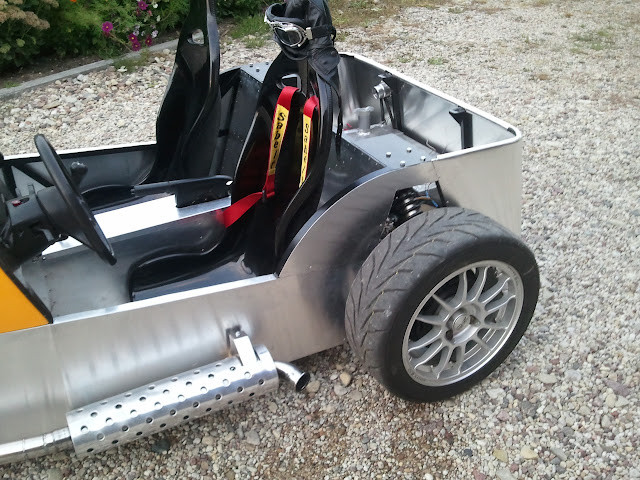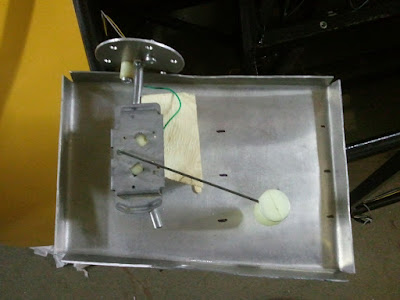
 |
|
#1
|
||||
|
||||
|
Hello everyone, I have a few questions regarding fuel tank manufacture...
I'm using a 2.0 Silvertop Zetec running my own Megasquirt EFI / ECU. What fuel pipe should I use for my feed and return lines? Should it be rigid or flexible? I'm using a standard Mondeo fuel rail, what fittings will I need to push onto this? Which fuel filler caps would people recommend? I'm still undecided as to whether to leave the filler on top of the tank or route it to the rear bodypanel. If I was to route it, how have others done it? Can anyone suggest a suitable swirl pot and pump to operate at ~180bhp @ 4bar? And will I have to incorporate a sump into my tank design? What have people been using for a fuel level sender for the gauge? Sorry for all the questions, thanks in advance for any replies! Josh |
|
#2
|
|||
|
|||
|
Most of the fuel lines can be rigid, but you will need flexible tubing where movement or vibration can be a problem e.g. into the inlet manifold and fuel pump. This has to be marked as suitable for carrying fuel.
|
|
#3
|
||||
|
||||
|
My 2¢.
I ran an 8 mm copper pipe inside the transmission tunnel, 8 mm fuel hose elsewhere. I used a brake flaring kit to make beads on the ends of copper pipe. Fuel hose comes in low-pressure (carb) and high-pressure (efi) varieties. There were pieces of rubber hose on my Mondeo fuel rail. In the middle there were some smart metal-plastic joints that require a special tool to open. I just obliterated the plastic part and was left with a nice 8 mm steel tube to connect my hoses. I have the "budget" (60 quid, yeah, right, "budget") aero fuel cap from the group buy (like this: http://www.cbsonline.co.uk/product/B...minium_AERO694). I have it mounted on the rear panel and joined to the tank with a 90 degree silicone hose bend. Filling in is fiddly, I have to drip fuel in at very low rate, otherwise it's splashing out and the pistol cut-off is kicking in. My cap is positioned like this:  I just integrated a ~13x13x7 cm rectangular swirlpot to my tank. That's 1 litre of fuel, should be good for 10 km or so ;-) The hole from the tank to the swirlpot is about 1-2" in diameter and is central to the pot. The intake is also in the swirlpot's bottom center, and the return comes to the swirlpot rather than tank. I had no fuelling interruptions with this setup even with the tank near-empty. Since I use the Sierra cluster for now, I used the Sierra's sender, too. In the carbed Sierra, The sender sits on the fuel pickup pipe. I cut out a part of that pipe and made an adapter for the 6 x ø60.7 (or what's that standard fuel sender PCD) fiment. The length of the float arm fit the book tank almost perfectly.  I hope this makes sense.
__________________
Albert Haynes Roadster FAQ | Haynes Builder Locations Gallery, build thread in Lithuanian / via Google Translate. |
|
#4
|
||||
|
||||
|
Thanks for the info Albert, plenty for me to digest!
What thickness and grade aluminium did you use to build your tank? I have enough 2mm ali left over from my floor sections to fold the main section of the tank, but I'll need to source more to make the end plates/baffle/swirlpot. In your build photos I see you've placed a gasoline filter in the fuel feed line (I think?) Would you suggest I use one too? And what is the the item mounted next to it? Thanks Josh |
|
#5
|
||||
|
||||
|
An inline fuel filter of some sort is absolutely essential do not leave it out unless you want never ending trouble with either carb or injection
|
|
#6
|
||||
|
||||
|
I used the leftover 2 mm half-hard. People commented that it's overkill. And, yes, 2 filters: the tin can one after the pump and the cheap plastic one before the pump!
__________________
Albert Haynes Roadster FAQ | Haynes Builder Locations Gallery, build thread in Lithuanian / via Google Translate. |
|
#7
|
|||
|
|||
|
Dont forget a large fuel filter also adds a smal amount of capacity to the system as well as filtering !
__________________
Cost : Little as possible. Thanks : To those who by their generosity my build has progressed. Its a handmade sports car not a flaming kit car !!! If at first you dont succeed,avoid skydiving... No parachute require to freefall,only if you want to do it twice. |
|
#8
|
|||
|
|||
|
Flyerncle raises a damn good point, it also provides similar function to a small swirl pot. When I took my Jag to bits I was very surprised to note that there were no swirl pots in the tanks - they were exactly the same as the carburetor version tanks. Then I realised there is a very large fuel filter and a non return valve - the filter is at the engine end, the valve ensures it is always full. Voila - one swirl pot. Took me a good while to understand why my FI system did not suffer from fuel surge. If it works for something as thirsty as an ancient V12 it should work for most other vehicles too.
Last edited by Enoch : 5th August 2013 at 02:11 PM. Reason: hopefully it makes sense now |
|
#9
|
||||
|
||||
|
I'm not sure the filter volume is much help -- as soon as the pump sucks in air, fuel pressure drops.
__________________
Albert Haynes Roadster FAQ | Haynes Builder Locations Gallery, build thread in Lithuanian / via Google Translate. |
|
#10
|
|||
|
|||
|
Hi Alga, I assume that's where the one way valve comes in somehow. The pump lives in the boot, it is fed from one of 2 petrol tanks. The outlet from the pump goes to this valve, the outlet from the valve runs to the front of the car where this massive (about 1/4 litre) filter sits. There is no baffling in the tank and no swirl pot that I can see inside the tank. They do slope so maybe the fact that the pickup is right at the bottom of the lowest point is sufficient to ensure continuous feed unless the tank is really low. The only reason I can think of to have such a big filter is to provide a small anti surge reservoir. It can't be for flow rate as it's only about a 5mm bore for the inlet and outlet.
|
 |
| Thread Tools | |
| Display Modes | |
|
|